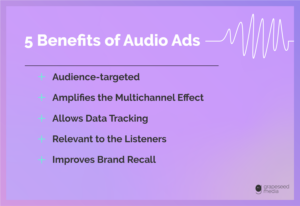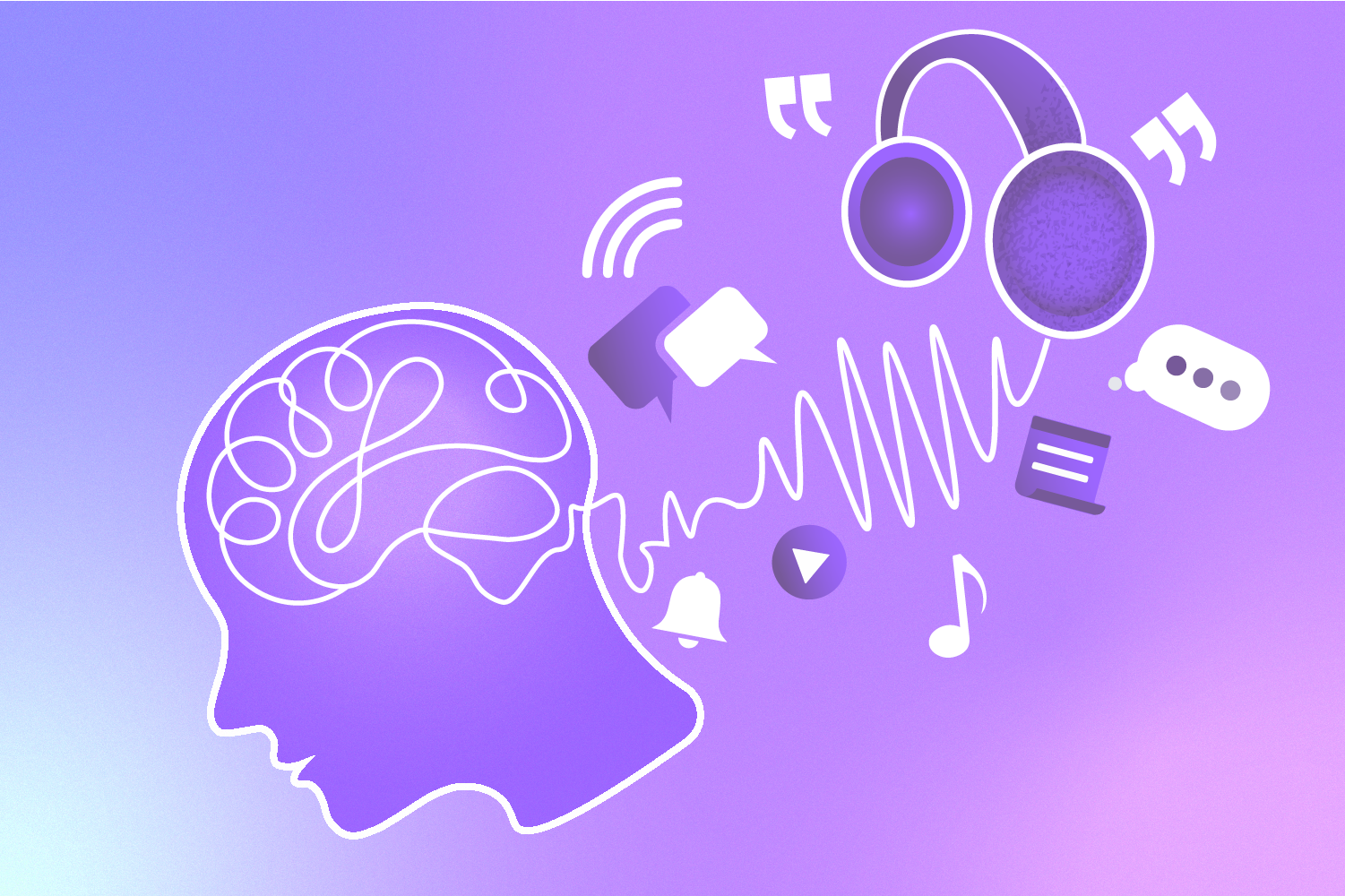The popularity of digital audio content has been growing for a few years, but the COVID-19 pandemic caused a sudden spike in audio content consumption.
Podcast audiences grew by 42% in 2020 as users reached for their devices to pass the time while they sheltered in place.
Savvy marketers seized the opportunity to tap into this new and growing market through digital audio advertising. This article will explain how you can join them.
Today, we’ll take a deep dive into audio advertising, its benefits, and how you can harness its potential.
What is Audio Advertising?
Audio advertising is a type of advertising designed for digital audio content in a diverse range of audio formats. An increasing number of brands are turning to programmatic audio ads that allow them to deliver targeted adverts in real-time, based on user location and behavior.
Programmatic audio advertising uses data and technology to evaluate each listener on a 1:1 basis so that advertisers can bid on consumers that fit their brand and serve them relevant digital audio ads. These usually consist of a 15-to 30-second prerecorded message, along with a display banner and call-to-action.
When integrated into a brand’s ad campaigns, audio advertising creates a personalized ad experience that is more likely to lead to conversions.
What are the Types of Audio Advertising?
Digital audio consumers are everywhere you look — literally. Next time you’re out and about you’re bound to see people with earphones on the subway, buying a coffee, or out running or walking in the park. So what are they listening to? Let’s take a look.
Podcast Ads
Podcasts have been growing in popularity year on year for a while now, and 2021 is no exception. The US podcast audience alone is expected to hit 117.8 million this year — a 10.1% increase compared to 2020.
Not only that, but 55% of people say they’ve bought a product after hearing about it on a podcast. This makes podcasts a powerful advertising platform for marketers who want to ramp up their brand awareness.
There are two main types of ad format for podcasts:
- Pre-produced ads of up to 30 seconds that are delivered programmatically.
- Native ads are often delivered off-script by the presenter as part of the podcast content. These ads are not programmatic.
Streaming Audio Ads
In 2020, the number of American adults listening to digital audio surpassed the number of radio listeners.
The advantage of streaming platforms such as Spotify and Pandora is that they gather user data that allows brands to insert targeted messaging into users’ playlists. This makes audio ads more targeted and more likely to convert than the one-to-many approach of traditional radio ads.
Some of the other main music streaming services include:
- iHeart Radio
- Amazon Music
- Google Play
Digital Radio Ads
Despite the drop in digital radio ad spending, which shrank by 17% in 2020, the use of programmatic advertising for digital radio is growing.
In 2020, 16.5% of digital radio ads were programmatic, with that figure expected to rise to 21% by 2022.
Voice-activated Ads
The rise of smart speakers has brought with it the possibility of voice-activated ads that allow listeners to make purchases hands-free — for example, while cooking or driving.
This takes the potential of an audio ad platform beyond brand awareness and provides the opportunity to convert in real-time.
5 Benefits of Audio Advertising
You might be wondering by now if audio advertising is really worth the hype or whether it’s just going to add more tasks to your to-do list. If you’re still on the fence, here are five reasons why programmatic audio advertising is so effective.
1. It’s Audience-Targeted
Programmatic audio ads let you target users based on location, behavior, and demographic. This means that two people in the same location can get different ads and brands can reach their ideal audience more easily.
2. It Amplifies the Multi-Channel Effect
Every marketer knows Dr. Jeffrey Lant’s famous rule of seven about the number of touches the average prospect requires before conversion.
Audio ads help raise brand awareness, for example, 60% of podcast listeners are more likely to make a purchase after hearing branded messaging on a podcast.
3. It Allows Data Tracking
Programmatic audio ads allow brands or agencies to collect data on key metrics, such as completion rate — whether a user listens to an ad all the way to the end or skips past it. You can also track behavior post-ad consumption.
4. It’s Relevant to the Listener
Programmatic targeting gives you the possibility to deliver relevant ads based on the listener’s interests or location.
For example, David moved from New Jersey to London, where he still tunes in to his favorite New York Giants podcast. But because the programmatic ads are location-specific, he received geographically relevant ads regarding the UK’s COVID-19 vaccination campaign.
5. It Improves Brand Recall
According to Nielsen, audio ads have 24% more recall compared to display ads, and 61% of podcast users were more likely to buy after exposure to audio ads for well-known national brands.

Bonus Benefit:
For the duration of the audio ad, a free companion banner (dependent upon publisher) is present on-screen. This allows a user to take action using a one-click pathway to the brand’s website.
This provides considerable added value to your audio ad buy, and helps marry the visual brand with your audio messaging.
What’s the Difference Between Audio Advertising and Radio Advertising?
Audio advertising refers to advertising to consumers of any type of digital audio content, from music streaming to podcasts, and it’s usually programmatic. Radio advertising is limited to radio station audiences, and is sometimes programmatic, but remains a mostly one-to-many strategy.
One of the most common objections to audio advertising is “are there enough listeners?”
And the answer is yes.
Radio advertising limits your audience to the number of listeners at a particular station. It is less targeted and less likely to convert.
With audio ads, everyone with a digital device is potentially a member of your target audience — that’s 240 million smartphone owners, 149 million tablet owners, and 48 million smartwatch owners in the US alone.
And the ever-growing popularity of digital audio content shows no signs of slowing down. In the first half of 2020, there were 72.1 million digital music subscribers, and the number of podcast listeners in the US is growing by 16% each year.
How Can Audio Advertising Fit Into A Marketing Strategy?
You might think of audio ads as top-of-funnel, but retargeting makes them ideal for mid-and lower-funnel, too.
For example, if someone is driving when they hear your ad, they might not necessarily be able to take action right away. But you can retarget them later on another device or platform with a different ad format.
Alternatively, if someone has looked at tickets for your theater website but hasn’t bought yet, you can retarget them with an audio ad.
This means that audio advertising fits seamlessly into your marketing strategy, complements marketing efforts on other channels such as display or social media, and amplifies brand awareness.

What are the Benefits of Partnering with Audio Ad Specialists?
An increasing number of brands are adding audio advertising to their marketing strategies, with podcast ad spending in the US expected to surpass $1 billion in 2021. Brands want audio ads, and agencies need to be ready to offer clients the most diverse marketing suite available.
Partnering with programmatic audio ad specialists like those on the Grapeseed team gives you immediate access to all platforms in the digital audio marketplace, saving you hours of work.
Plus, we stay on top of trends in the audio space so you can stay ahead of your competitors and diversify your marketing channels in a way that integrates with your current marketing strategy.
Ready to get started with Audio Advertising?
Just as video marketing was the big trend of the 2010s, audio advertising is having a moment. Now is the time to take advantage of the growing digital audio market.
Want a more in-depth insight into why audio advertising is set to rule in 2023? Check out our blog post on the power of programmatic audio.
But introducing a new marketing service such as audio advertising can be a real headache, so let us take it off your hands.
At Grapeseed, we’re passionate about helping our clients grow through customized digital advertising. Get in touch to learn more about adding audio ads to your services — we’ll get back to you within 24 hours.






